Funabashi Grand Oasis (Funabashi City, Chiba Prefecture)Community Development with 100% Renewable Energy
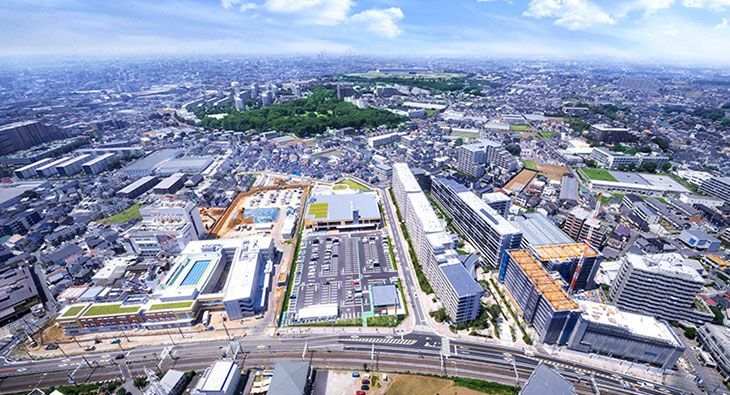
1.Project Overview
Outline of the project
At the former factory site, we planned to implement a large-scale mixed-use development project with a total area of 57,456.19 m², consisting of condominiums and rental housing on the north side of the development site, single-family housing on the southwest side, and commercial facilities on the south side.

■Outline of the project
- Location
- 1-50, Gyouda, Funabashi City, Chiba Prefecture
- Project area
- 57,456.19 m2
- Site area
- 47,601.38 m2
- Total construction period
- From Aug. 2018 to Mar. 2021
- Total cost
- Approx. 26 billion yen
- Facility description
- Commercial complex
Condominiums: 571 units
Rental housing (high-rise): 223 units
Rental housing (low-rise): 39 units
Single-family housing: 26 blocks
■Project background
- Sep. 2012
- Factory closed
- Jul. 2018
- Land purchase agreement signed
- Aug. 2018
- Development approved
- Nov. 2019
- Development work completed
- Mar. 31, 2021
- Completed
2. Town-wide Initiatives
Overview
Daiwa House Group's community development
With respect to climate change mitigation and adaptation, the Daiwa House Group is promoting "decarbonization" through three phases (products and services, in-house activities, and procurement) and has set a goal called "Challenge ZERO 2055," with the aim of achieving "zero" environmental impact by 2055, the 100th year since Daiwa House Industry's founding.
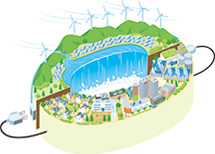
Challenge ZERO 2055
Community Development with 100% Renewable Energy
In this project, our Environment Energy Division is mainly supplying renewable electricity. We used renewable electricity as the power source for construction work in the residential and commercial facility zones. In addition, the Environment Energy Division and others supply electricity used by residents at single-family houses, condominiums, and rental housing, as well as electricity used in common areas and for streetlights.
Of the 394 renewable-energy power plants*1 managed and operated by the Group nationwide (with a generating capacity of approximately 446 MW), we supply mainly electricity generated at the Suganuma Hydroelectric Power Plant (generating output of approximately 2 MW) *2 in Hida City, Gifu Prefecture, which began full-scale operation in October 2018. By purchasing non-fossil certificates (with tracking)*3 which certify that the electricity is generated by this power plant, we are able to realize community development that uses only renewable-energy electricity and that complies with the international "RE100"*4 rules and specifications.
- *1 As of December 31, 2020, including scheduled operation
- *2 Electricity is supplied through a specified wholesale supply contract between Suganuma Hydroelectric Power Plant and this project. In the event of an electricity shortage, power is supplied from other renewable-energy power plants managed and operated by the Group.
- *3 Non-fossil certificates separate the environmental value (such as emitting no greenhouse gases, etc.) of electricity derived from renewable-energy generation, etc., and make it tradable. By adding the tracking, it is possible to identify the power plants from which the environmental value is derived.
- *4 An international initiative on renewable energy run by the Climate Group, an international non-profit organization.
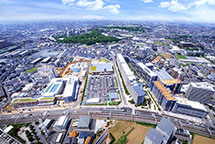
Funabashi Grand Oasis
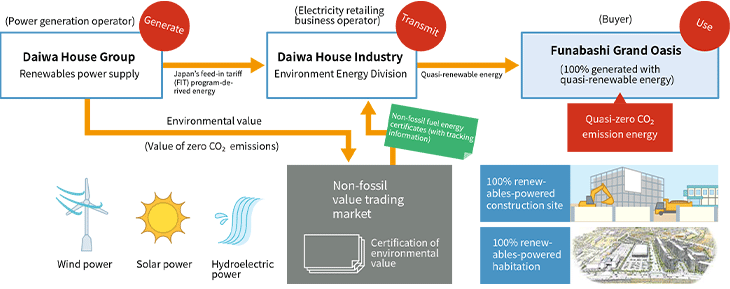
Scheme diagram of community development with 100% renewable energy
The CO2 emissions reduction effect at Funabashi Grand Oasis is expected to be 750.5t-CO2/year*5, a 74.4% reduction compared to the reference emissions of a typical building, which are 2,934.9t-CO2/year.*6
- *5 CO2 emissions from gas use
- *6 Excluding commercial facilities
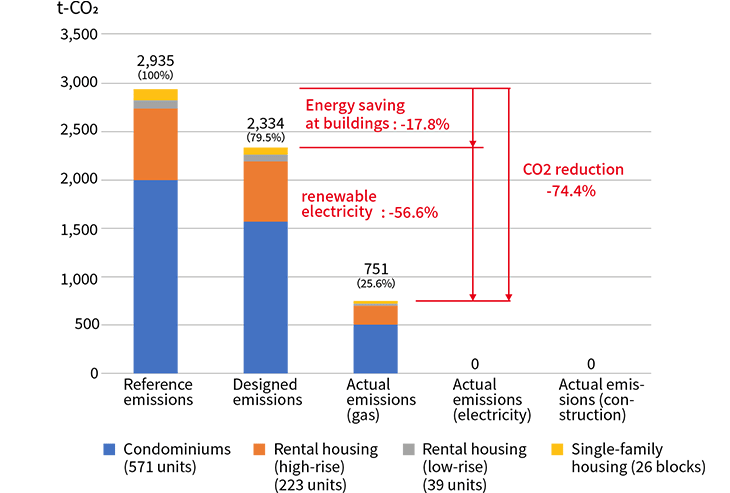
Illustration aiming at promoting and educating about renewable energy
The urban development under the 100% renewables-powered environment was expressed by an illustration drawn on the temporary fencing at the construction site. The illustration was designed to catch the attention of people passing by the construction site by using expressions that are understandable to both children and adults who are unfamiliar with renewable energy. We are actively involved in promoting and educating the public about renewable energy, and will continue to create towns that utilize clean electricity at many of our construction sites in the future.

Illustration painted on fencing
at site
3. Initiatives at Condominium: "PREMIST Funabashi Tsukada"
Overview
Our condominium brand, PREMIST, proposes condominiums with high asset value and with consideration for the environment and disaster prevention to add more value for society and our customers.
At PREMIST Funabashi Tsukada, we have implemented a variety of advanced initiatives to reduce the environmental impact. The main initiatives are:
(1) Peak shaving
(2) Output adjustment according to demand
(3) Real-time indicator

(Photo taken in August 2020)
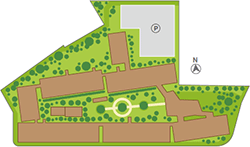
Condominiums zone
(1) Peak shaving
In a condominium, during normal time zones when power use increases, electricity stored in lithium-ion storage batteries from the solar power generation system is discharged and used for the electricity in common areas. This automatically reduces the peak power consumption of the entire condominium. In the event of a power outage, the lithium-ion storage batteries are used to supply electricity to specific equipment.
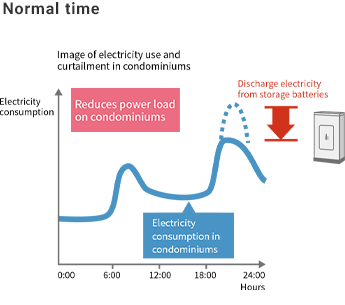
- Use the surplus of electricity in common areas of condominiums
- To shave the peak usage of power, a fixed amount of electricity is discharged from storage batteries during periods of high electricity usage in condominiums
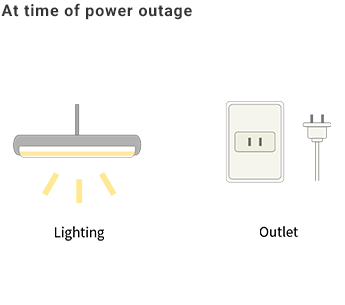
- Provides power to specific equipment at time of power outage
(2) Output adjustment according to demand
The system monitors the energy usage of the entire condominium complex and controls the air conditioning if the power consumption is expected to exceed the capacity set in the demand controller.
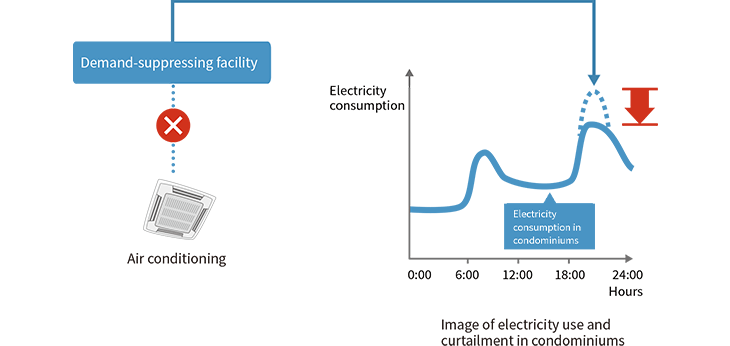
(3) Real-time indicators
Real-time indicators that show "how much electricity is being used right now" are installed in each house to inform the residents of their electricity usage status in red, yellow, and green colors in real time. At the same time, a variable charge system based on the electricity load is designed to allow the residents to take reasonable power-saving behavior, leading to a reduction in electricity bills.

4. Initiatives at Single-Family Houses "SECUREA Funabashi Grand Oasis"
Overview
A town with energy self-sufficiency
The concept of the "energy self-sufficient town" that we are working on is to "use" energy in the town with energy "made" in the town. We aimed to create a town where energy produced by it is not sold, but consumed within the community with the concept of local production for local consumption.
Power interchange among single-family houses
At SECUREA Funabashi Grand Oasis, we have created a town block where "electric power is interchanged" among single-family houses. In the past, we realized the "interchange system for electric power among single-family houses" at SECUREA Toyota Kakimoto (Toyota City, Aichi Prefecture). This time, we have increased the number of houses that join this system. While there are limits to the efficient use of energy in individual houses, more efficient energy consumption is possible by working on an entire city block. SECUREA Funabashi Grand Oasis aims to achieve a "renewable energy lifestyle" by consuming as much of the electricity generated in the town as possible.
All single-family houses are equipped with solar power generation systems, lithium-ion storage batteries, and energy management systems (EMS) for effective control of equipment, and linked with the Internet communication network. As in the case of SECUREA Toyota Kakimoto (sales completed), the project consists of town blocks for the power interchange system, but in this case, the number of blocks has been increased and a more advanced energy management system using AI has been developed and introduced.
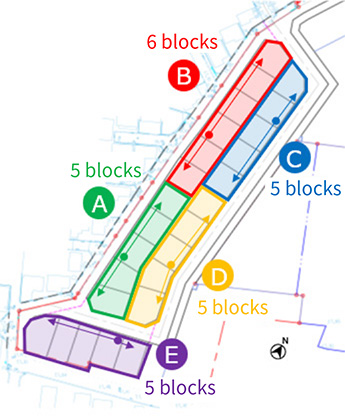
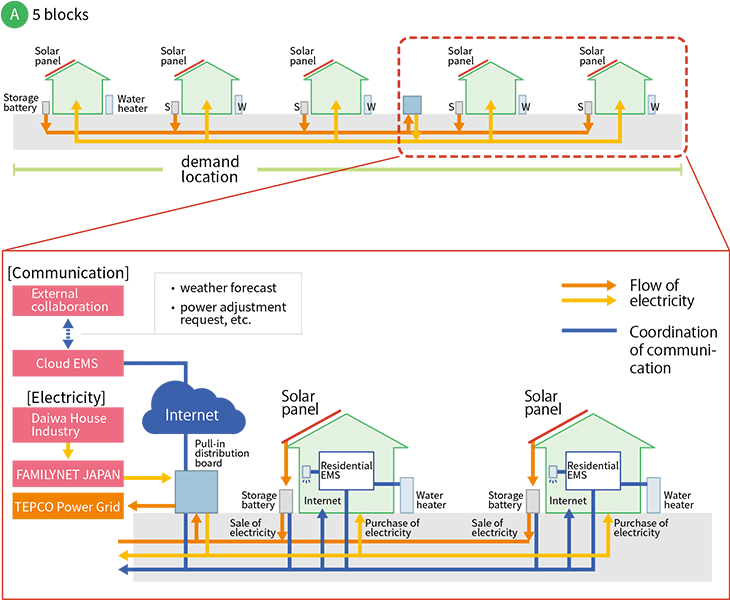
This electricity interchange system was made possible by combining the control technologies we have cultivated in the residential sector through our SMA x ECO TOWN TOWN projects and the knowledge gained by FAMILYNET JAPAN CORPORATION in its electricity and Internet provider services. The 26 blocks are divided into five groups, with TEPCO Power Grid, Incorporated purchasing the photovoltaic-generated power and discharged power from the storage batteries. Daiwa House Industry supplies electricity, and FAMILYNET JAPAN distributes it to each residence using a lump-sum power receiving system. In addition, the company provides telecommunication services by drawing not only electricity but also telecommunications through pull-in distribution boards.
Based on the data analysis of the actual cases at SECUREA Toyota Kakimoto, we have added further control functions. In addition to the solar power generation and electricity usage status of each house, data such as calendars and weather information have been added, and these are analyzed by cloud-based AI to enable more optimal remote control of the lithium-ion storage batteries and water heaters. This allows customers to maximize their homes' self-consumption rates without being conscious of their lifestyles.
5. Initiatives at Rental Housing
Overview
In our high-rise rental housing (Royal Parks Funabashi) and low-rise rental housing, we use renewable energy generated by our company to supply 100% renewable energy to our residential customers.
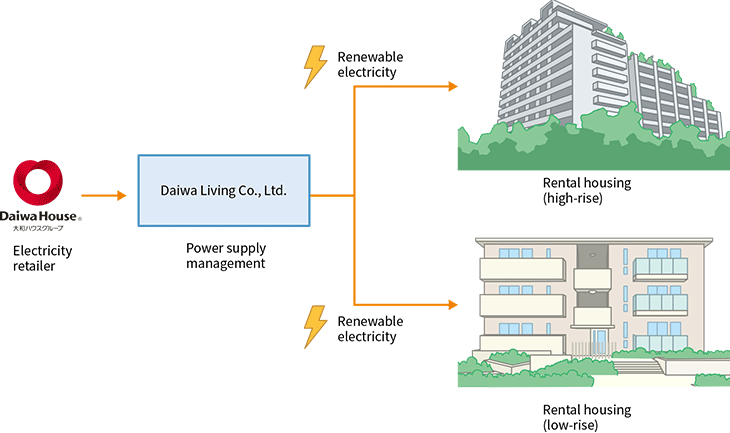
Voice of the Person in Charge
Promoting decarbonized towns with 100% renewables-powered energy
Funabashi Grand Oasis has realized a town where all electricity used in the town, including the construction phase, is 100% renewables-powered energy. In recent years, the effects of climate change, such as torrential rains and increasing extremely hot days, have had a significant impact on our daily lives and corporate activities. Since the Paris Agreement adopted in 2015, countries around the world have been strengthening their efforts to address climate change, and the roles and expectations of companies are also increasing. We will continue to promote environmentally friendly urban development in various ways.

Tokyo Head Office
Tokyo Urban Development Department
Planning & Administration Section
Daigo Watanabe



